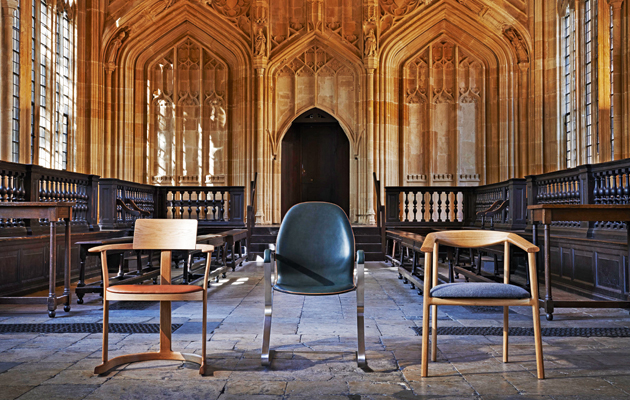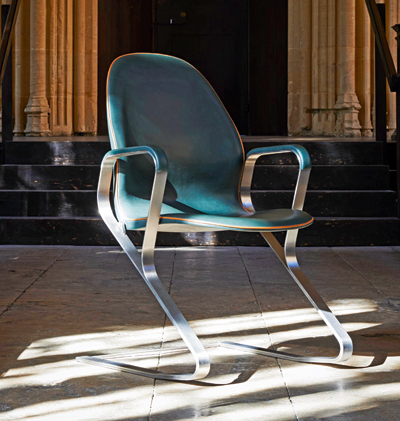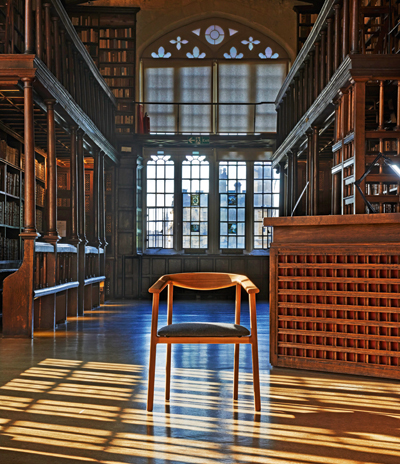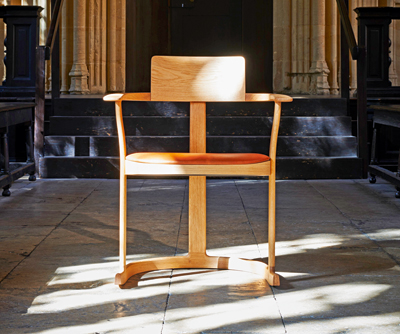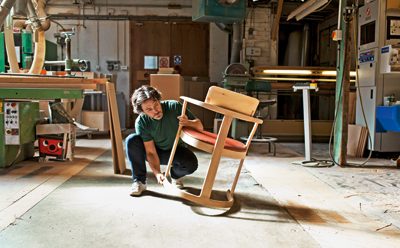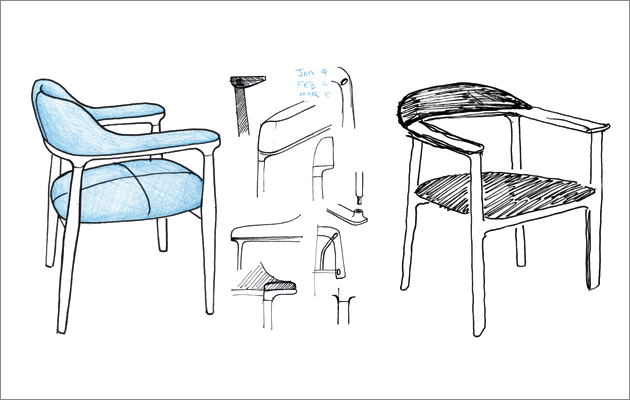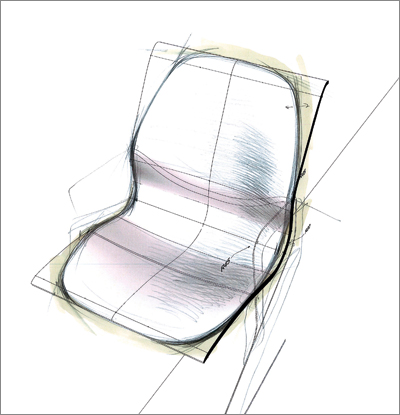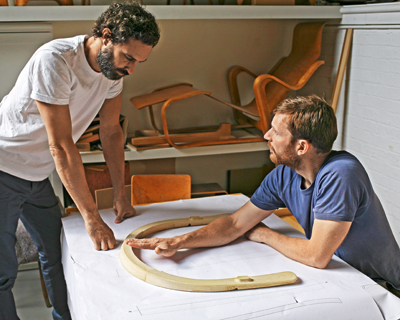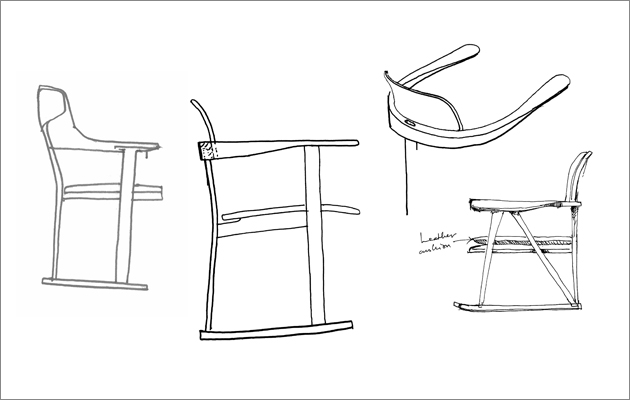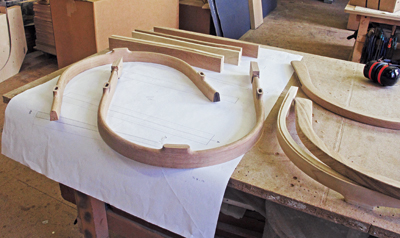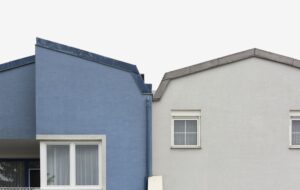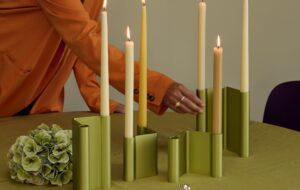|
|
||
|
Following a long-established tradition, Oxford University’s world-renowned Bodleian Library invited the design industry to create a new chair for its readers – a deceptively complex brief that yielded wildly different results from the shortlisted British finalists, Barber Osgerby, AL_A and Matthew Hilton Oxford University’s Bodleian Library is one of the oldest libraries in Europe. First opened to scholars in 1602, it houses more than 11 million books across a number of locations, including a 15th-century building in the centre of Oxford; it employs more than 600 librarians, and, by law, can request a copy of any book published in the UK. To this day, no books are loaned to readers, so the reading rooms are at the heart of the library’s workings. Since the mid-18th century, when chairs were first introduced in the library, specially commissioned seating has played an important role in these spaces and their comfort. Important commissions include the 1756 curator’s chair, a replica of which is still sold in the Bodleian shop; a 19th-century commission; and a chair devised by architect Sir Giles Gilbert Scott for the New Bodleian library he designed in the 1930s. Earlier this year, the Bodleian held a design competition – the first of its kind – to design a new reader’s chair for the library. The competition is part of a major effort to refurbish and renew the mid-20th century Scott building as a centre for special collections, including manuscripts, archives and rare books – which will be known as the Weston Library. The project, by Wilkinson Eyre Architects, aims not only to create new reading rooms that meet the needs of contemporary readers, but also to open up the collections to new audiences through exhibitions and public engagement.
AL_A’s final stainless steel and leather chair prototype “The reason for holding the competition is this tradition of having bespoke chairs for the Bodleian library,” Jim Eyre, principal of Wilkinson Eyre, says. “I think the Bodleian quite likes the idea of having a special chair they can use in the library and that might get used elsewhere.” It is an opinion the Bodleian’s librarian Richard Ovenden shares. “We don’t get this opportunity very often in libraries,” he says. “The UK has become such a centre for innovation in furniture design, and we wanted to see how the community would respond to our call. We were absolutely delighted with the depth and strength of the response.” More than 60 design studios from across the UK expressed interest in the competition, which asked designers to choose a local manufacturer to work with. Eight shortlisted designers were asked to produce concepts (two shortlisted designers Simon Pengelly and Benjamin Hubert, withdrew). From this, three finalists – AL_A, Matthew Hilton and Barber Osgerby – were asked to produce prototypes.
Matthew Hilton’s chair was the most traditional For all three finalists, the competition was a chance to be part of a prestigious project for a British institution, and the library commission presented a particularly challenging opportunity on a number of levels. AL_A, for example, saw the potential to explore different scales and new technologies. “We’re architects, not furniture designers, but a smaller scale is integral to how we work,” says associate Maximiliano Arrocet, “Occasionally, we get the opportunity to do something as exciting as this. We thought that it was a great opportunity to go on one of our adventures with furniture.” Matthew Hilton had not previously worked on a library chair and was excited by the prospect of investigating a new typology. For Barber Osgerby, meanwhile, the motivation was simple: “We just fancied it,” says Osgerby, who grew up in Oxfordshire. Each design studio shares a close relationship with the partnering manufacturer, lending the competition a sense of camaraderie. Isokon, for example, produced Barber Osgerby’s very first piece of furniture, while AL_A has a long history with Herman Miller (the local manufacturer is also fabricating several custom doors for its V&A project). Matthew Hilton has developed several projects with SCP.
The semi-circular plan of Barber Osgerby’s chair enables a free range of movement Readers sit in the library studying manuscripts for up to ten hours at a time, so comfort was central to the brief. Also important was the way in which readers are now using new technologies in the Bodleian – they still look at rare historic manuscripts that need to be supported by specially designed foam blocks, but they now also take notes “How people are using that kind of technology that has an impact on the way they sit on the chair,” Eyre says. “You sit in a different posture when you’re writing by hand compared with when you’re using a laptop. Some of the prototyped chairs have a facility for a slight forward tip. Being able to move in the chair and being able to move the chair quite easily are quite important as comfort criteria. People sit there for long periods of time, but they don’t necessarily sit still.”
Barber Osgerby worked with Isokon For Barber Osgerby, this was the most unusual aspect of the brief. “Most chairs aren’t designed for that level of comfort,” says Osgerby. “And nobody is going to be comfortable sitting still for eight hours.” Thus, they designed their chair with a semi-circular plan that enables a free range of movement. A minimal use of materials and a large contact point at the base ensures the chair is also easy to manoeuvre and push around. Hilton observed similar behaviours in the readers and responded with a chair that, although more traditional in its appearance than Barber Osgerby’s, has a similar approach to material use and manoeuvrability. “There was quite a strong feeling from the library that they wanted a link to tradition,” Hilton says of his classic approach. “We decided that they weren’t looking for a task chair – although with Herman Miller involved we’re now not sure.” |
Words Mandi Keighran
Prototypes for the Bodleian chair by all three finalists: Barber Osgerby, AL_A and Matthew Hilton
Image: Jamie Smith |
|
|
||
|
Matthew Hilton’s chair |
||
|
AL_A and Herman Miller, however, toyed with the idea of a chair that incorporated moving elements, but also decided that a task chair was not what the library was looking for. “In the end, we preferred to have an option without a mechanical part or moveable parts like a task chair,” Arrocet says. “It was a difficult decision, because if you want to accommodate everyone, the easiest thing is to have moveable parts.”
Designs by Maximiliano Arrocet’ design team at AL_A (above and below) Instead, AL_A used Herman Miller’s expertise in ergonomics to design a sleek and contemporary shell that would comfortably accommodate various body shapes and a diversity of sitting positions. While the newly refurbished Weston Library will be a light, open, contemporary space, many of its historical features are being retained and restored – especially in the new reading rooms where the winning chair will be used. The challenge for the designers was to balance references to the historic spaces and previously commissioned Bodleian chairs, and this is perhaps where the three chairs differ most. |
||
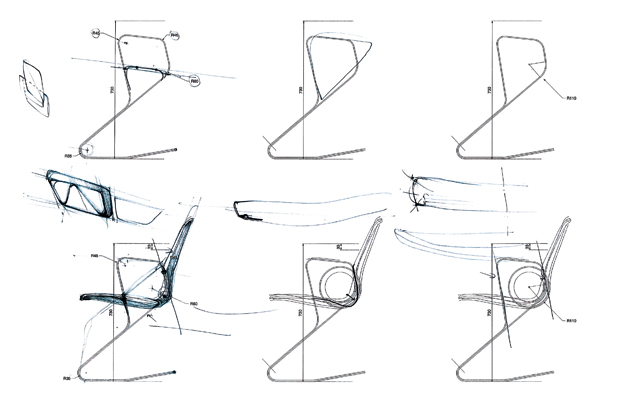 |
||
|
Hilton’s timber and upholstered chair is a classic interpretation of a library chair, and it is easy to see where its reference lie. “It’s an area I’m comfortable working in,” Hilton says. “I have respect for the past.”
Barber Osgerby worked with Isokon “There is a resonance of history in the leather,” Arrocet says. “You know you are sitting down with generations of people who were excellent in whatever they were studying. We found that this materiality was very important. I think the chair looks very contemporary, but I still think that, through the materiality, we were trying to achieve the same things that we took from predecessors.” Somewhere between these two extremes of interpretation is Barber Osgerby’s entry, a chair that references the previous Bodleian chairs made of wood, yet whose unusual form – which has drawn comparisons to the Daleks from Doctor Who – is thoroughly contemporary. |
||
|
Sketches for Barber Osgerby’s chair |
||
|
With three such vastly different concepts to choose between, making a decision was always going to be difficult. In the end, however, after a rigorous judging process that included testing with readers, architects from Wilkinson Eyre, and the Bodleian’s librarians, the winning team was Barber Osgerby and Isokon. “The winning chair has a very iconic feel to it,” Ovenden says. “The aesthetic really suited the mixture of the modern and historic parts of the building, and we could see the chair working well in both those spaces.” In particular, the competition’s judging panel appreciated the subtle reference to the verticality of Scott’s architecture – which can be seen in the windows of the New Bodleian, as well as in both Tate Modern and Battersea Power Station – in the back of Barber Osgerby’s chair, an element that provides a powerful contextual reference and gives the chair a visual lightness and strong identity. Jay Barber and Edward Osgerby were delighted with the decision. Their work, however, isn’t yet over and they’re looking forward to developing the finished chair. “While the prototype gives a good visualisation of the finished chair, there is still a long way to go,” the designers say. “It will be a great day when the chairs are finally installed in the Bodleian in a year’s time.”
Barber Osgerby’s chair was designed to be light and easy to move around |
||

